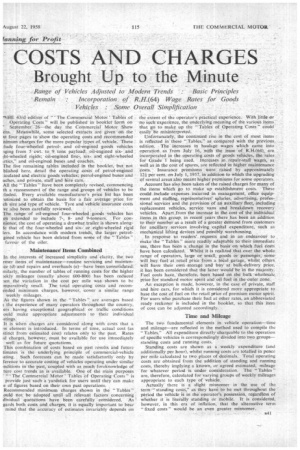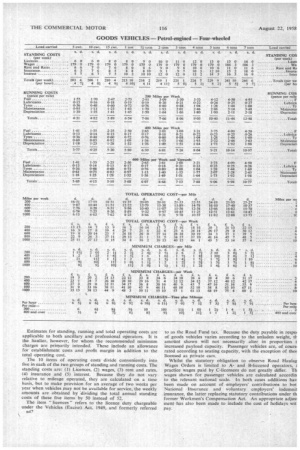COSTS AND CHARGES
Page 75

Page 76

Page 77

If you've noticed an error in this article please click here to report it so we can fix it.
Brought Up to the Minute
• Range of Vehicles Adjusted to Modern Trends . .Basic Principles
• Remain Incorporation. of . R.II.(64) Wage Rates for Goods Vehicles : Some Overall Simplification
-11-1E 43td edition of The Commercial Motor Tables of Operating Costs" will be published in booklet form on
September-26—the day the Commercial Motor -Show ens. Meanwhile, some selected extracts are given on the at four 'pages to' show the operating costs and recommended nirninn charges for the more popular 'types .01 vehicle; These Jude four-wheeled petroland oil-engined :goods vehicles aging from 5 cwt. to '9.-tons payload;:..oil-engined
;ht-wheelcd rigids; oil-engined five-, sixand eight-wheeled Vies," and oil-engined buses and coaches.
The five remaining tables included. in the booklet, but not blished here, detail the operating costs of petrol-engined :iculated and electric goods vehicles; petrol-engined bilka and aches, and private, staff and hire cars:
All the " Tables" have been completely revised, commencing th a reassessment of the range and groups of vehicles to be :guded. Every available manufacturer's price list has been utinized to obtain the basis for a fair average price for ch size and type of vehicle. Tyre and vehicle insurance cots ye also been carefully reviewed.
The range of oil-engined four-wheeled goods vehicles has en extended to include 7-, 8and 9-tonners. For coii!. nience, the cost of operating a drawbar trailer is shOwn alongle that of the four-wheeled and six-. or -eight-wheeled rigid lers. In accordance with modern trendS, the largerpetrolgincd vehicle has been deleted from some of the Tables' favour of the oiler.
MaintenanceItems Combined In the interests of increased simplicity and clarity, the two finer items of maintenance—routine servicing and maintentee (ti) and repairs and overhauls (e)—have been Consolidated: milarly, the number of tables of running costs for the .higher ekly mileages (usually -above 600-800) has been reduced len the variation in the cost per mile was shown to be ri-iparatively small. The. total _operating costs and recornended minimum charges; however, Cover a similar range weekly. mileages.
As the figures shownin the "Tables". are averages based the experience of many operators throughout the country, ers having exceptional geographical: or traffic conditions ould make appropriate adjustments to their individual
stings.. ..
It is when charges are considered along with costs that a m element is introduced. In terms of time, actual cost (as Stinet from estimated cost) relates only to the past. Rates id charges, ho-Wever, must be available for use immediately well as for future quotations.
This combination of costs based on past results and future timates is the underlying • principle of commercial-vehicle ,sting. Such forecasts can be made satisfactorily' Only by ference to accurate costing of vehicles operating under similar .riditioris in-the past;coupled With as much foreknowledge of tore cost (rends as is available: One of the niain purposes " The commercial. Motor' Tables Of Operating-Costs" is Provide just stitch a 'yaidstick for users Until they -can make e of figures based on their own past operations.
Recommended minimum charges shown in the "Tables" mid .riot. be adopted until all relevant factors concerning dividual quotations haVe been carefully considered. As garcis both costs. and charges; it is equally important to bear mind that the accuracy of estimates invariably depends on . the extent of the operator's practical experience. With_litlIe;.or no such experience the underlying meariihg of the various items that go to make up the " Tables of ,Operating Costs " cOuld' easilV' be misinterpreted. Unfortunately, the continued 'rise in the cost of most items is reflected in these ".Tables,r as compared with the previons, edition. . The increases in haulage wages which came into operation as from July., 16, with the issue of it.I-1.(64), are incorporated in the .operating costs of goods. vehicles, the 'fates for" Grade 1.' being Used. increases in ; repair-staff wage, as well as in the cost of spares, are reflected in higher maintenance :costs .1 Insurance premiums were raised by approximately 124 per cent. on July 1, 1957, in addition to which the upgrading Of several areas also meant higher prerniunts for some operators. Account has also been taken of the raised charges for Many of the items which go to make up establishment costs. These could include expenses incurred in management, office equipment and staffing, representatives' salaries, advertising, profes-.. sional services -and the provision of an auxiliary fleet, including
. replacement vehicles, service vans and breakdown recovery vehicles. Apart:,from the increase in the cost of the individual items in this group, in recent years there has been an addition to their number as a result Of a greater demand from customers for ancillary services involving capital expenditure, such as mechanical lifting devices and pOssiblY Warehousing,
: In response, to readers', requests' and in an endeavour to make the "Tables" More readily' adaptable to their immediate use there hasbeen a change in the basis on which fuel costs have been calculated. Whilst it Is realized that over the whole range of operators, large or small, goods or passenger; some will buy fuel at retail price from a local garage Whilst others will haVe their own -Storage and buy at bulk-delivery price, it has been considered that the latter would' be in the majority. Fuel costs have therefore; been based on the bulk 'wholesale_ price for standard motor spirit and oil fuel in the outer zone.
An exception is made, however, in the case of private, staff and hire cars, for which it is considered more appropriate to base the cost of fuel on the retail price of premium motor spirit. For users who purchase their fuel at other rates, an abbreviated ready reckoner is included in the booklet, so that this item of cost can be adjusted accordingly.
Time and Mileage The two fundamental elements in vehicle operation—time and mileage—are reflected in the method used to compile the "Tables." All expenditure directly chargeable to the operation of specific vehicles is correspondingly divided into two groups— standing costs and running costs.
Standing costs are shown as a weekly expenditure (and additionally per hour), whilst running costs are totalled in pence per mile calculated to two places of decimals. Total operating costs are obtained from the addition of standing and running costs, thereby implying a known, or agreed estimated, mileage • for whatever period is under consideration. The "Tables" are, therefore, calculated for varying groups of weekly mileages appropriate to each type of vehicle.
• Actually. there is a slight misnomer in the use of the term •" standing coStS," as they have to be met throughout the period the vehicle is in the operator's. possession, regardless of whether it is literally standing or mobile. It" is eonsidered, however, in this era of inflation, that the alternative term "fixed costs" would be an even greater misnomer.
Estimates for standing, running and total operating costs are applicable to both ancillary and professional operators. It is the haulier, however, for whom the recommended minimum charges are primarily intended. These include an allowance for establishment costs and profit margin in addition to the total operating cost.
The 10 items of operating costs divide conveniently into five in each of the two groups of standing and running costs. The standing costs are: (1) Licences, (2) wages, (3) rent and rates, (4) insurance and (5) interest. Because they do not vary relative to mileage operated, they are calculated on a time basis, but to make provision for an average of two weeks per year when vehicles may not be available for service, the weekly amounts are obtained by "dividing the total annual standing costs of these five items by 50 instead of 52.
The item " licences" refers to the licence duty chargeable under the Vehicles (Excise) Act. 1949, and formerly referred n4/
to as the Road Fund tax. Because the duty payable in respei of goods vehicles varies according to the unladen weight, th amount shown will not necessarily alter in proportion t increased payload capacity. Passenger vehicles are, of courst rated according to seating capacity, with the exception of dim licensed as private cars.
Whilst the statutory obligation to observe Road Haulag Wages Orders is limited to Aand B-licensed operators, i practice wages paid by C-licensees do not greatly differ. Th wages shown for passenger vehicles are calculated accordin to the relevant national scale. In both cases additions hay been made on account of employers' contributions to bot National Insurance and voluntary employers' indemnit insurance, the latter replacing statutory contributions under th former Workmen's Compensation Act. An appropriate adjust ment-has also been made to include the cost of holidays wit pay. he cost of vehicle insurance is based on full comprehensive el and in the case of goods vehicles relates to ancillary ration in medium-risk areas.
unning costs are those which are incurred only when the icle is operated and, with limited exceptions, vary directly relation to mileage, assuming average operational conditions, e five. items are: (1) Fuel, (2) lubricants, (3) tyres, (4) mainance and (5) depreciation. As mentioned earlier, fuel is ed on bulk-delivery Prices-petrol at 3s. 9d. per gallon
• oil fuel (derv) at 3s, 10d. per gallon. As in previous editions of the "Tables," depreciation is lculated on a mileage basis, with the life of vehicles in the wer-priced groups assessed at 125,000 miles; rising to 250,000 r the "heavies." An exception, however, is made in depreding private, staff and hire cars. This course has been followed in keeping • with the modern tendency for frequent replacement in an endeavour to obtain both maximum availability-of vehicles and advantage of mass-production methods.
The full "Tables of Operating Costs" include two articles on systematic cost recording and the recording of tyre costs, the addresses of Licensing Authorities and Traffic Commissioners, Road Haulage AssOciation area secretaries, Trader's' Road 'Transport AsSociation divisional secretaries • and Passenger Vehicle Operators' Association area secretaries.
An extract from R.H.(64) is also given, with alternative fuel costs for individual operators to make appropriate adjustments where necessary. There is also a 10-year comparison of the three major items of cost-vehicle prices, wages and the price of fuel. The third includes details of changes in fuel tax,-S.13.




















































































































